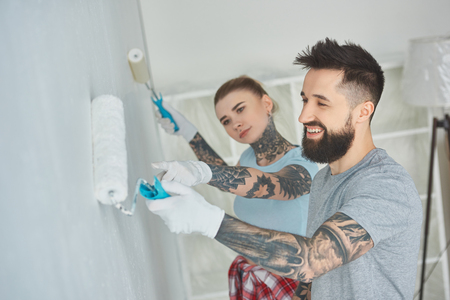1. Planning Your Budget-Friendly Bathroom Remodel
Before swinging a hammer or picking out tile samples, its crucial to start your bathroom remodel with a solid plan. Remodeling on a budget doesn’t mean you have to sacrifice style or quality—it just means making smart choices and knowing where to spend and where to save.
Set a Realistic Budget
Start by figuring out how much youre willing and able to spend. Be honest about your finances and consider setting aside an extra 10-15% for unexpected expenses—because surprises happen, especially in older bathrooms.
| Remodeling Task | Estimated Cost Range (DIY) | Estimated Cost Range (Pro) |
|---|---|---|
| Painting Walls & Ceiling | $50 – $150 | $200 – $500 |
| Installing New Vanity | $150 – $400 | $500 – $1,200 |
| Tiling Floor | $200 – $600 | $800 – $2,000 |
| Updating Fixtures (faucets, lights) | $100 – $300 | $300 – $800 |
Prioritize Must-Have Changes
Not every part of your bathroom needs a makeover. Make a list of what absolutely needs updating—like a leaky faucet or cracked tiles—and what would simply be nice to have—like a rainfall showerhead. Focus your budget on essentials first.
Tip:
If your tub is in good shape, consider re-glazing it instead of replacing—it can save hundreds of dollars!
Create a Simple Project Plan
Mapping out your remodeling steps helps keep you on track and prevents overspending. Break down the project into phases like demolition, plumbing updates, painting, installing fixtures, and final touches. This way, you can tackle one task at a time without feeling overwhelmed or running out of funds mid-project.
Example Project Timeline:
- Week 1: Demolition & Repairs
- Week 2: Plumbing & Electrical Updates
- Week 3: Painting & Tiling
- Week 4: Install Vanity, Fixtures & Final Touches
A little planning goes a long way when remodeling your bathroom on a budget. With clear priorities and a realistic spending plan, youll set yourself up for success from the start.
Choosing Affordable Materials and Fixtures
Remodeling your bathroom on a budget doesn’t mean sacrificing style or quality. With a little research and smart shopping, you can find affordable materials and fixtures that not only look great but also last for years. Heres how to make budget-friendly choices for the essentials in your bathroom renovation.
Tiles: Stylish Yet Budget-Conscious Options
Tiles can make a big impact on your bathrooms overall look, but they can also be expensive. To keep costs down, consider these alternatives:
| Tile Option | Description | Average Cost per Sq. Ft. |
|---|---|---|
| Ceramic Tiles | Durable, water-resistant, and available in many styles and colors | $1 – $5 |
| Porcelain Tiles | Slightly more durable than ceramic; good for floors and walls | $3 – $7 |
| Peel-and-Stick Tiles | Great for DIYers; easy to install and remove | $1 – $3 |
| Laminated Panels | Mimic tile look without grout; quick installation | $2 – $4 |
Vanities: Functional and Affordable Choices
A vanity is both a storage solution and a design focal point. Instead of buying high-end pieces, try these cost-effective strategies:
- Refinish your existing vanity: A fresh coat of paint and new hardware can make it look brand new.
- IKEA or flat-pack vanities: Modern designs at lower prices, perfect for DIY assembly.
- Dresser-to-vanity conversions: Repurpose an old dresser by adding a sink—stylish and unique!
Lighting: Bright Ideas That Save Money
The right lighting transforms your bathroom’s mood. Look for energy-efficient options that are easy on the wallet:
- LED Light Fixtures: Long-lasting and energy-saving bulbs reduce electricity bills over time.
- Sconces & Vanity Lights: Affordable designs available at most home improvement stores like Home Depot or Lowe’s.
- Dimmable Options: Add flexibility with dimmable lights for ambiance without overspending.
Sinks, Faucets & Toilets: Budget-Friendly Upgrades
You don’t have to buy top-of-the-line brands to get reliable fixtures. Here are some tips to save money while updating key components:
- Sinks: Drop-in or pedestal sinks are often cheaper than undermount options.
- Faucets: Stick to basic models from reputable brands; they offer good warranties at lower prices.
- Toilets: Dual-flush models help conserve water and come in affordable ranges under $200.
Your Local Hardware Store Is Your Best Friend
Avoid fancy showrooms—instead, explore local stores, clearance sales, and online marketplaces like Facebook Marketplace or Craigslist. You might score gently used or surplus items at a fraction of the price.
If youre open to mixing and matching different elements, youll be surprised how stylish your bathroom can look—without draining your savings account.

3. DIY Demolition and Prep Work
Before you start installing new fixtures or picking out paint colors, you’ll need to tear out the old stuff. Doing your own demolition and prep work is one of the easiest ways to save money during a bathroom remodel. With some basic tools and safety precautions, you can take on this step yourself and get your space ready for transformation.
Stay Safe First
Demolition might seem like fun, but safety should always come first. Make sure to wear protective gear like gloves, safety goggles, a dust mask, and sturdy shoes. Turn off the water supply to avoid leaks, and cut power to any outlets in the bathroom before working near them.
Basic Safety Checklist:
| Task | Why It Matters |
|---|---|
| Turn off water supply | Prevents flooding and pipe damage |
| Shut off electricity | Avoids shock when removing fixtures |
| Wear safety gear | Protects eyes, hands, and lungs from debris |
Tools You’ll Need
You don’t need heavy-duty construction tools to do most bathroom demolition tasks. Heres a list of common tools that will help you get started:
- Pry bar
- Sledgehammer (for larger fixtures)
- Screwdrivers (flathead and Phillips)
- Utility knife
- Buckets and trash bags for debris
- Crowbar for tile removal
Tearing Out Old Fixtures
If youre replacing the vanity, toilet, or bathtub, remove them carefully so you don’t damage plumbing or surrounding surfaces. Take photos of plumbing connections before disassembly – it helps during reinstallation later.
- Sinks & Vanities: Disconnect water lines first. Then unscrew the vanity from the wall.
- Toilets: Shut off the water valve, flush to empty the tank, then unbolt from the floor.
- Tubs: This may require cutting through caulk and removing surrounding tiles or drywall.
Patching Walls and Cleaning Up
Once everything’s out, inspect the walls and subfloor. Patch up holes with joint compound and replace any rotted wood or water-damaged drywall. Sweep up debris and vacuum dust thoroughly — a clean workspace makes installation much smoother.
Your DIY Demo Timeline (Estimated)
| Task | Time Needed |
|---|---|
| Sink & Vanity Removal | Around 1–2 hours |
| Toilet Removal | Around 30–60 minutes |
| Tub Removal | Around 2–4 hours (may vary) |
| Patching & Cleanup | Around 1–2 hours |
This phase takes some elbow grease but sets the foundation for everything else. Doing it yourself not only saves hundreds of dollars in labor costs—it also gives you a better understanding of your home’s structure as you move forward with your budget-friendly bathroom remodel.
4. Updating Walls, Flooring, and Paint
Giving your bathroom a fresh look doesn’t have to cost a fortune. By updating the walls, flooring, and paint with budget-friendly materials, you can completely transform the space without breaking the bank. Here’s a step-by-step guide to help you refresh your bathroom using affordable options like paint, peel-and-stick tiles, or vinyl flooring.
Step 1: Choose Your Color Palette
Start by selecting a color scheme that reflects your style and makes the space feel brighter and cleaner. Light colors like soft grays, blues, or classic white work great in small bathrooms as they create an open and airy feel.
Popular Budget-Friendly Paint Colors:
| Color | Vibe | Best For |
|---|---|---|
| Soft Gray | Modern & Calm | Contemporary Bathrooms |
| Light Blue | Fresh & Coastal | Small or Windowless Bathrooms |
| Crisp White | Clean & Timeless | All Bathroom Types |
Step 2: Prep and Paint the Walls
Before painting, clean the walls thoroughly to remove any dust or grime. Use painter’s tape to protect trim and fixtures. Apply a primer if needed, then follow with one or two coats of your chosen paint. Opt for mold- and mildew-resistant paint designed specifically for bathrooms.
Step 3: Install Peel-and-Stick Wall Tiles (Optional)
If you want to add texture or an accent wall without spending much, consider peel-and-stick tiles. They come in various styles—from faux subway tile to mosaic—and are super easy to apply.
How to Apply Peel-and-Stick Wall Tiles:
- Measure the area you want to cover.
- Clean the surface thoroughly and let it dry.
- Peel off the backing and carefully stick the tile starting from one corner.
- Smooth out air bubbles as you go using a plastic smoother or credit card.
Step 4: Update the Flooring with Vinyl or Peel-and-Stick Tiles
If your bathroom floor is outdated, vinyl plank flooring or peel-and-stick floor tiles are excellent low-cost options that mimic more expensive materials like hardwood or ceramic tile.
Budget-Friendly Flooring Options:
| Material | Look & Feel | Estimated Cost per sq ft |
|---|---|---|
| Peel-and-Stick Vinyl Tiles | Easy DIY, Many Patterns Available | $0.50–$2.00 |
| Vinyl Plank Flooring | Mimics Wood, Waterproof Options Available | $1.00–$3.00 |
Installation Tips:
- Clean the subfloor: Make sure it’s smooth and dry before installing new flooring.
- Create a layout plan: Dry-fit a few pieces first to see how they’ll line up.
- Use a utility knife: Cut pieces to fit around corners or fixtures easily.
- Add trim if needed: Finish off edges with quarter-round molding for a clean look.
This part of your remodel has big visual impact for relatively little money. With just some paint and stick-on surfaces, you can make your bathroom feel brand-new while staying on budget.
5. Installing Fixtures and Finishing Touches
Now that your bathroom is coming together, its time to install the fixtures and add those small finishing touches that make a big impact—all without blowing your budget. With a bit of planning and some DIY spirit, you can tackle this step like a pro.
Install a New Sink and Faucet
If youve chosen a budget-friendly vanity with an included sink, youre already ahead. If not, swapping out your old sink and faucet can still be simple and affordable. Look for combo deals at home improvement stores or online. Many come with basic installation kits.
Tips for Installing Your Sink and Faucet:
- Turn off the water supply before starting any plumbing work.
- Use plumbers tape on threaded connections to prevent leaks.
- Follow manufacturer instructions closely—most include diagrams and step-by-step guidance.
- If replacing only the faucet, measure existing holes to ensure compatibility with the new one.
Upgrade Lighting Without Rewiring
Updating light fixtures can instantly modernize your bathroom. Choose LED vanity lights or wall sconces that match your style but are still energy-efficient. If youre not comfortable with electrical work, consider plug-in lighting options that don’t require rewiring.
Budget-Friendly Lighting Options:
| Type | Estimated Cost | Installation Notes |
|---|---|---|
| LED Vanity Bar | $30–$70 | Simple wall mount; some models plug into outlets |
| Wall Sconces (Pair) | $40–$80 | Mounts near mirror; check for wiring compatibility |
| Stick-on LED Lights | $15–$30 | No wiring needed; battery-operated or USB-charged |
Add Accessories That Tie It All Together
This is where your personal style really shines. Think towel bars, toilet paper holders, mirrors, shower curtains, and rugs. You dont have to buy everything new—consider spray-painting existing hardware or shopping thrift stores for unique finds.
Finishing Touch Ideas:
- Towel Hooks or Bars: Easy to install with just a screwdriver; look for sets under $20.
- Framed Mirror: Adds character; swap out a builder-grade mirror for a framed one from a discount store.
- Floating Shelves: Great for storage and décor; install above the toilet or next to the vanity.
- Curtains & Rugs: Affordable ways to introduce color and texture—coordinate them for a cohesive look.
The key to success in this step is taking your time and choosing items that are both functional and affordable. With these final upgrades, your budget bathroom remodel will feel polished and complete.


